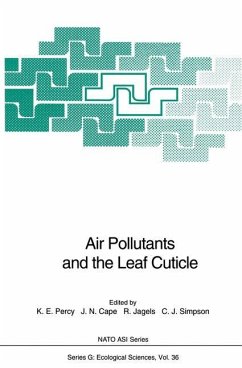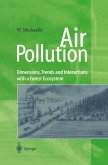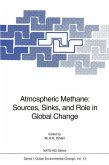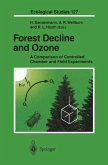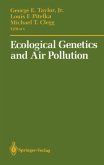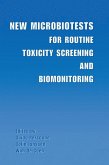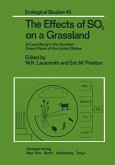Air Pollutants and the Leaf Cuticle
Herausgegeben von Percy, Kevin E.; Cape, J. Neil; Jagels, Richard; Simpson, Caroline J.
Air Pollutants and the Leaf Cuticle
Herausgegeben von Percy, Kevin E.; Cape, J. Neil; Jagels, Richard; Simpson, Caroline J.
- Broschiertes Buch
- Merkliste
- Auf die Merkliste
- Bewerten Bewerten
- Teilen
- Produkt teilen
- Produkterinnerung
- Produkterinnerung
Plant leaves are covered by a thin, lipoidal, non-living membrane called the cuticle. Forming the interface between plants and the atmospheric environment, it presents an effective barrier to pollutant entry. The book provides a comprehensive review of air pollutant effects on the cuticle and covers the following thematic areas: - Cuticular physicochemical characteristics, physiological, regulatory, and protective roles. - Effects, mechanisms, and consequences of air pollutant interaction with leaf cuticles. - Non-anthropogenic and environmental influences on the cuticle and potential of the…mehr
Andere Kunden interessierten sich auch für
![Air Pollution Air Pollution]() Walfried MichaelisAir Pollution76,99 €
Walfried MichaelisAir Pollution76,99 €![Atmospheric Methane: Sources, Sinks, and Role in Global Change Atmospheric Methane: Sources, Sinks, and Role in Global Change]() Atmospheric Methane: Sources, Sinks, and Role in Global Change115,99 €
Atmospheric Methane: Sources, Sinks, and Role in Global Change115,99 €![Forest Decline and Ozone Forest Decline and Ozone]() Forest Decline and Ozone151,99 €
Forest Decline and Ozone151,99 €![Ecological Genetics and Air Pollution Ecological Genetics and Air Pollution]() Ecological Genetics and Air Pollution39,99 €
Ecological Genetics and Air Pollution39,99 €![New Microbiotests for Routine Toxicity Screening and Biomonitoring New Microbiotests for Routine Toxicity Screening and Biomonitoring]() New Microbiotests for Routine Toxicity Screening and Biomonitoring113,99 €
New Microbiotests for Routine Toxicity Screening and Biomonitoring113,99 €![The Effects of SO2 on a Grassland The Effects of SO2 on a Grassland]() The Effects of SO2 on a Grassland77,99 €
The Effects of SO2 on a Grassland77,99 €![The Gulf War Aftermath The Gulf War Aftermath]() M. SadiqThe Gulf War Aftermath158,99 €
M. SadiqThe Gulf War Aftermath158,99 €-
-
-
Plant leaves are covered by a thin, lipoidal, non-living membrane called the cuticle. Forming the interface between plants and the atmospheric environment, it presents an effective barrier to pollutant entry.
The book provides a comprehensive review of air pollutant effects on the cuticle and covers the following thematic areas: - Cuticular physicochemical characteristics, physiological, regulatory, and protective roles. - Effects, mechanisms, and consequences of air pollutant interaction with leaf cuticles. - Non-anthropogenic and environmental influences on the cuticle and potential of the cuticle for biomonitoring and critical levels mapping. - New developments in experimental methodology and analytical techniques.
The book provides a comprehensive review of air pollutant effects on the cuticle and covers the following thematic areas: - Cuticular physicochemical characteristics, physiological, regulatory, and protective roles. - Effects, mechanisms, and consequences of air pollutant interaction with leaf cuticles. - Non-anthropogenic and environmental influences on the cuticle and potential of the cuticle for biomonitoring and critical levels mapping. - New developments in experimental methodology and analytical techniques.
Produktdetails
- Produktdetails
- Nato ASI Subseries G: 36
- Verlag: Springer / Springer Berlin Heidelberg / Springer, Berlin
- Artikelnr. des Verlages: 978-3-642-79083-6
- Seitenzahl: 412
- Erscheinungstermin: 25. Dezember 2011
- Englisch
- Abmessung: 235mm x 155mm x 23mm
- Gewicht: 622g
- ISBN-13: 9783642790836
- ISBN-10: 3642790836
- Artikelnr.: 36121061
- Herstellerkennzeichnung
- Springer-Verlag GmbH
- Tiergartenstr. 17
- 69121 Heidelberg
- ProductSafety@springernature.com
- Nato ASI Subseries G: 36
- Verlag: Springer / Springer Berlin Heidelberg / Springer, Berlin
- Artikelnr. des Verlages: 978-3-642-79083-6
- Seitenzahl: 412
- Erscheinungstermin: 25. Dezember 2011
- Englisch
- Abmessung: 235mm x 155mm x 23mm
- Gewicht: 622g
- ISBN-13: 9783642790836
- ISBN-10: 3642790836
- Artikelnr.: 36121061
- Herstellerkennzeichnung
- Springer-Verlag GmbH
- Tiergartenstr. 17
- 69121 Heidelberg
- ProductSafety@springernature.com
Section I - Reviews.- Plant Cuticles: Physicochemical Characteristics and Biosynthesis.- Modelling Pollutant Deposition to Vegetation: Scaling Down from the Canopy to the Biochemical Level.- Air Pollutants and Plant Cuticles: Mechanisms of Gas and Water Transport, and Effects on Water Permeability.- Ion Transport across Leaf Cuticles: Concepts and Mechanisms.- Effects of Air Pollutants on Epicuticular Wax Chemical Composition.- Effects of Air Pollutants on Epicuticular Wax Structure.- Leaf Wettability as a Measure of Air Pollution Effects.- Air Pollutants and the Cuticle: Implications for Plant Physiology.- Cuticular Characteristics in the Detection of Plant Stress Due to Air Pollution - New Problems in the Use of These Cuticular Characteristics.- Evaluation of Pollutant Critical Levels from Leaf Surface Characteristics.- New Analytical Techniques for Cuticle Chemical Analysis.- Leaf Cuticles as Mediators of Environmental Influences: New Developments in the Use of Isolated Cuticles.- Section II - New Methods and Contributions.- The Effect of the Environment on the Structure, Quantity and Composition of Spruce Needle Wax.- Effect of Ozone and Elevated Carbon Dioxide on Cuticular Membrane Ultrastructure of Yellow Poplar (Liriodendrontulipifera).- Spatial Distribution of Sulphate Uptake by Wind-Damaged Beech Leaves.- Effects of UV-B Radiation on Wax Biosynthesis.- Effects of Acid Rain and Surfactant Pollution on the Foliar Structure of Some Tree Species.- Fourier Transform IR Studies on the Interaction of Selected Chemicals with Isolated Cuticles.- Effects of Wind and Simulated Acid Mist on Leaf Cuticles.- Measurements and Modelling of Ozone Deposition to Wet Foliage.- Section III - Effects and Biomonitoring.- The Effect of Age, Canopy Position and Elevation on FoliarWettability of Picearubens and Abiesbalsamea: Implications for Pollutant-Induced Epicuticular Wax Degradation.- Effect of Elevation and Foliar Age on Maximum Leaf Resistance to Water Vapor Diffusion in Conifers of the Central Rocky Mountains, USA.- The Effects of Pine (Pinussylvestris L.) Needle Surface Wax Layer Structure on Water Loss and Uptake of 14C02 and 35S02.- Effects of Acid Mist on Needle Surface and Water Status of Piceaabies.- Effect of High Dose SO2 and Ethylene Exposure on the Structure of Epicuticular Wax of Piceapungens.- Preliminary Observations on the Influence on Increasing Atmospheric CO2 Levels on Cuticular Waxes of Spruce Needles.- Effects of Ozone Exposures on Epicuticular Wax of Ponderosa Pine Needles.- Observations on the Effects of Acid Rain Treatment on Needle Surfaces of Scots Pine and Norway Spruce Seedlings.- Problems in Interpreting Effects of Air Pollutants on Spruce Epicuticular Waxes.- Recent Advances Using Electron Beam Analysis to Detect Cuticular Changes Induced by Air Pollution.- Physico-Chemical Characteristics of Pine Needle Surfaces Exposed to Different Air Pollution Sources.- A Comparison of Epicuticular Wax of Pinus sylvestris Needles from Three Sites in Ireland.- Characteristics and Geographical Distribution of the Changes in Scots Pine Needle Surfaces in Finnish Lapland and the Kola Peninsula.- Forest Health Monitoring by the Canadian Forest Service: Now and the Future.- Section IV - Rapporteurs' Reports.- Session 1.- Session 2.- Session 3.- Session 4.- Session 5.- Session 6.- Recommendations by Participants.- List of Participants.
Section I - Reviews.- Plant Cuticles: Physicochemical Characteristics and Biosynthesis.- Modelling Pollutant Deposition to Vegetation: Scaling Down from the Canopy to the Biochemical Level.- Air Pollutants and Plant Cuticles: Mechanisms of Gas and Water Transport, and Effects on Water Permeability.- Ion Transport across Leaf Cuticles: Concepts and Mechanisms.- Effects of Air Pollutants on Epicuticular Wax Chemical Composition.- Effects of Air Pollutants on Epicuticular Wax Structure.- Leaf Wettability as a Measure of Air Pollution Effects.- Air Pollutants and the Cuticle: Implications for Plant Physiology.- Cuticular Characteristics in the Detection of Plant Stress Due to Air Pollution - New Problems in the Use of These Cuticular Characteristics.- Evaluation of Pollutant Critical Levels from Leaf Surface Characteristics.- New Analytical Techniques for Cuticle Chemical Analysis.- Leaf Cuticles as Mediators of Environmental Influences: New Developments in the Use of Isolated Cuticles.- Section II - New Methods and Contributions.- The Effect of the Environment on the Structure, Quantity and Composition of Spruce Needle Wax.- Effect of Ozone and Elevated Carbon Dioxide on Cuticular Membrane Ultrastructure of Yellow Poplar (Liriodendrontulipifera).- Spatial Distribution of Sulphate Uptake by Wind-Damaged Beech Leaves.- Effects of UV-B Radiation on Wax Biosynthesis.- Effects of Acid Rain and Surfactant Pollution on the Foliar Structure of Some Tree Species.- Fourier Transform IR Studies on the Interaction of Selected Chemicals with Isolated Cuticles.- Effects of Wind and Simulated Acid Mist on Leaf Cuticles.- Measurements and Modelling of Ozone Deposition to Wet Foliage.- Section III - Effects and Biomonitoring.- The Effect of Age, Canopy Position and Elevation on FoliarWettability of Picearubens and Abiesbalsamea: Implications for Pollutant-Induced Epicuticular Wax Degradation.- Effect of Elevation and Foliar Age on Maximum Leaf Resistance to Water Vapor Diffusion in Conifers of the Central Rocky Mountains, USA.- The Effects of Pine (Pinussylvestris L.) Needle Surface Wax Layer Structure on Water Loss and Uptake of 14C02 and 35S02.- Effects of Acid Mist on Needle Surface and Water Status of Piceaabies.- Effect of High Dose SO2 and Ethylene Exposure on the Structure of Epicuticular Wax of Piceapungens.- Preliminary Observations on the Influence on Increasing Atmospheric CO2 Levels on Cuticular Waxes of Spruce Needles.- Effects of Ozone Exposures on Epicuticular Wax of Ponderosa Pine Needles.- Observations on the Effects of Acid Rain Treatment on Needle Surfaces of Scots Pine and Norway Spruce Seedlings.- Problems in Interpreting Effects of Air Pollutants on Spruce Epicuticular Waxes.- Recent Advances Using Electron Beam Analysis to Detect Cuticular Changes Induced by Air Pollution.- Physico-Chemical Characteristics of Pine Needle Surfaces Exposed to Different Air Pollution Sources.- A Comparison of Epicuticular Wax of Pinus sylvestris Needles from Three Sites in Ireland.- Characteristics and Geographical Distribution of the Changes in Scots Pine Needle Surfaces in Finnish Lapland and the Kola Peninsula.- Forest Health Monitoring by the Canadian Forest Service: Now and the Future.- Section IV - Rapporteurs' Reports.- Session 1.- Session 2.- Session 3.- Session 4.- Session 5.- Session 6.- Recommendations by Participants.- List of Participants.

